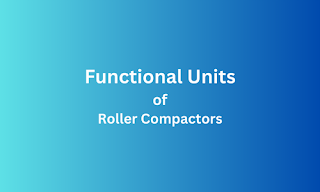If granulation is needed for processing a formulation or powder properly, one option is dry granulation, also known as roller compaction. Compared to the wet granulation process, in general during dry granulation no liquid is added. It is a mechanical process where the powder is densified between two rolls, resulting in a ribbon, and is then milled to granules.
Roller compactors generally consist of three functional units:
1. Feeding Unit (also called conveying unit or system):
On top of the roller compactor, a hopper is mounted. The hopper is usually equipped with an agitator for loosing up the poor flowable material and for avoiding bridging. From here, the material is conveyed into the densification unit, using one or more augers.
2. Densification Unit:
This is the central unit of a roller compactor. The powder is drawn-in into the gap (smallest distance between the rolls) by two counter-rotating rolls, resulting in a densification by applying a specific force between the two rolls. The orientation of the rolls may vary from one manufacturer to another.
3. Milling Unit (also called size reduction or classification unit):
An oscillating or rotating granulator mills the ribbons (or pieces of it) through a sieve. Most manufacturers perform the milling in one step, but also roller compactors with two milling steps are available.
Read also: Fluid Bed Granulation in Pharmaceutical Industry
According to the Thin Layer Model the powder wedge which is densified between the rolls can be divided into small layers (ref. to figure). Each layer applies a small force on the rolls and the sum of all these forces is the total force.
This force is proportional to the roll width. To eliminate the influence of the roll with and to be able to transfer the force settings to rollers with different width (but the same diameter) the force in roller compaction is expressed in kN/cm (roll width). It is called the specific roll force.
Read also: Factors Affecting Dissolution of Pharmaceutical Products
Fixed vs. variable gap roller compactor
Two types of roller compactors are available, so-called “fixed gap” or “variable gap” roller compactors. The difference can already be deducted by their name:
A fixed gap compactor has a constant gap during the process. For some types it can be adjusted to different values, but when it is set, the system keeps the gap constant.
As dry granulation is applied to increase the flowability of powders, in general poorly flowable material is roller compacted. Although the feed unit is built to level out the powder flow, it is still fluctuating. If the rollers are fixed these fluctuations result in unsteady compaction forces. Changes in the compaction force have a large impact on the densification and therefore on the granule’s properties. Unsteady powder flow in variable gap roller compactors result in fluctuating gaps, whereas the roll force stays constant. The impact on the ribbon density is minor and therefore the impact on the granule properties.
For dry granulation processes which need a constant and monitored product quality like in Pharma applications, variable gap roller compactors are mandatory.
Read also: Rapid Mixing Granulation Technique
Resource: Solids Development Consult


